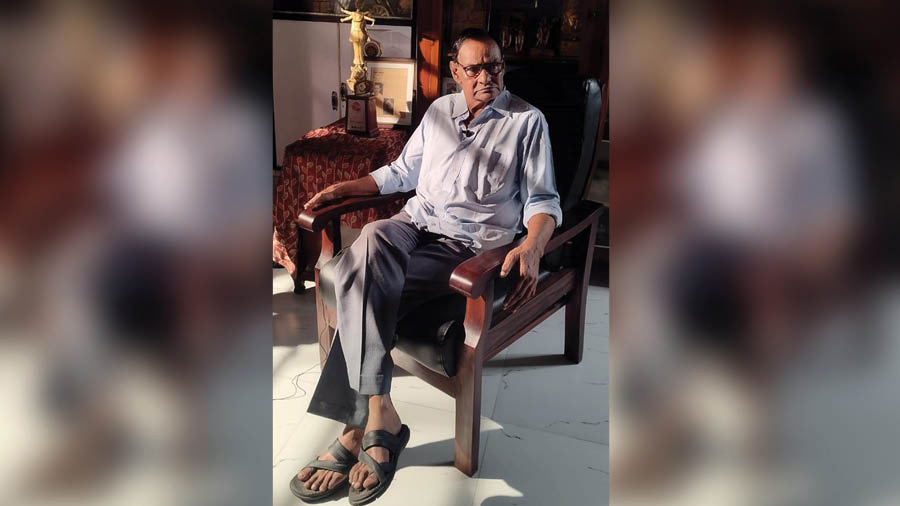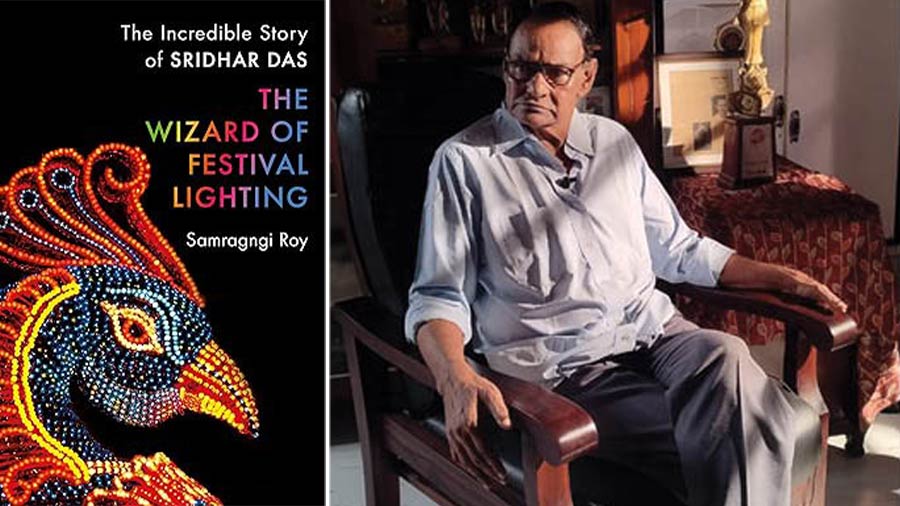“Let there be light!” said a 10-year-old boy when he was given Rs 10 to arrange lights for his school’s Saraswati Puja. A childish intrigue, an inexplicable fascination with lights and a head full of dreams propelled Sridhar Das to build an empire of lights in his hometown of Chandernagore. Not only putting the town on the map but also revolutionising how light is perceived on this side of the world, Das rightfully earned the epithet of the wizard of festival lighting.
All about a thought
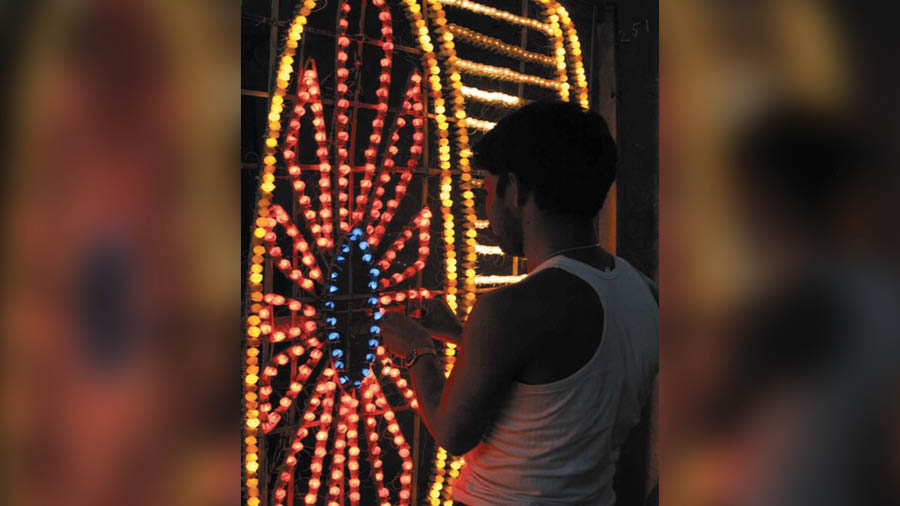
A light artist works on a wheel with 6.2 miniature light bulbs Photograph courtesy: Samragngi Roy
“It was all about a thought. And later, numerous thoughts coming together through lights,” said Sridhar, sipping on his morning tea, as My Kolkata visited him. “All about letting my imagination run amok. Just thoughts translated into light panels,” he said immediately, when asked about how he would describe his life’s work.
Retired for almost a decade, Sridhar likes being in his office to talk to people early in the morning — an office that has been graced by numerous notable people of rank and fame. And to him, it was this very contagious intrigue that drew people to him and his work. In more than five decades of turning his fascination into his profession, Das became a pioneer of festival lighting with his panels, arches, three-dimensional (3D) light figures illuminating Chandernagore along with Kolkata, Mumbai, Delhi, Moscow, London and Belfast. “I can’t name a place in India, where my lights have not travelled to,” he said, with an impish smile.
The flicker
A deviant to his parents, Sridhar was thoroughly averse to the concept of being caged by the school’s prescribed textbooks. He knew he’d be pushed to work at the jute mill like his father, and his mind wandered haywire, only to fixate on the concept of lights. Speaking of how he got drawn to lights, he said: “During the early-1950s, there was a private company which used to supply electricity to the whole of Chandernagore. Standing in front of the shop, I used to look at the lights for hours, enchanted by the entire concept. Tubelights had just come into the market and like any other kid, the entire visual of light in tubes fascinated me.”
Still in school, he started working as an apprentice at one of these shops. Confidently enough, he dropped out of school the following year, to dive deeper into the world of lights, dynamo motors, relays et al. His first gig came with a Jagaddhatri Pujo Baroari asking him to install lights for the gate. This was the first time he fashioned arches of automatic lights with rollers, which eventually made him a pioneer in the industry.
“When I brought my family along the very next day to show them the work I had done, my heart broke to see all my lights had been removed because they were unappealing. That is probably the day the fire inside me was ignited,” said Sridhar. The very next year he did the lights for another baroari which became a huge hit with people from neighbouring towns flooding in just to see the lights. He was the talk of the town. “I just wanted to make lights run in a pattern along the road.”
No ceiling to imagination
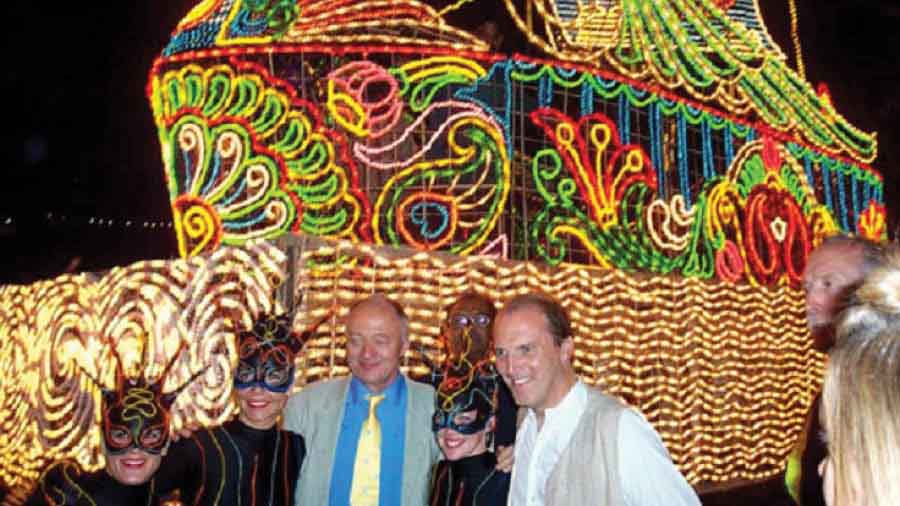
Mayurpankhi Bojra at The Thames Festival Photograph courtesy: Martin Good
Sridhar, according to granddaughter Samragngi Roy, knew no limits to frantic experimentation and imagination. With no formal degree or course to back him up, here was a man who decided to install lights underwater. “The people from the corporation rushed in to prevent me from getting electrocuted. I wanted to prove them wrong. I stood in the middle of the point and lit the bulbs underneath and even took a hammer and smashed a few of them to show them there was no hint of danger to my plan. I had insulated the bulbs with cable compounds and made the pond light up.” This prompted numerous baroari Durga pujos to approach him the following year itself and thus began his association with places in Kolkata, like College Square and Singhi Park.
Taking automatic lighting to new heights with his use of rollers and an artistic understanding of themes, Sridhar’s work drew worldwide acclaim. In addition to a spate of works and thematic experiments in Chandernagore as a part of the immersion procession carnival every year during Jagaddhatri Pujo, his works were also a part of the illumination at the Indian Festival in Russia. He also made the historic 3D Mayurpankhi Bojra for the Thames Festival in London, and participated in an exhibition at the Queen’s University Belfast, which still has the panels which were used, on display.
The man behind the artist

Sridhar Das with his granddaughter Samrangni Photograph courtesy: Samragngi Roy
For a man whose profession banked on mathematical precision, Sridhar fails to recollect details now, fumbling and finding it difficult to speak at a stretch, having been diagnosed with cerebral atrophy a few years ago. It is then Sridhar’s granddaughter Samragngi, an MBA student and a published author, decided to pen the story of his grandfather’s journey to tether him to his legacy and help him reconnect with his memories, with her book ‘The Wizard of Festival Lighting: The Incredible Story of Sridhar Das’.
“The first memory I have of my grandfather is of accompanying him to the factory behind our house which had all the lights, the panels and three-dimensional models created from scratch. It used to fascinate me as a kid and we used to have our house buzzing with people and journalists during the Pujo months. That is when I realised my grandfather was actually somebody important,” said Samragngi on how she was inducted into his grandfather’s world.
The world of lights had all but consumed Sridhar. Such was his penchant for perfection, he attended to all issues with his panels personally. “I was sitting on my biyer pniri and suddenly there was a call from a very important baroari that I worked for. They informed me of a suspected burning smell emanating from my arches. I left immediately, knowing that if I didn’t, something very serious could happen. My marriage could wait,” said Sridhar, smiling as he recounted the story. “Chandernagore would have probably got lights, but I wouldn’t be Sridhar Das if not for my wife. She has made me what I am, by pushing my imagination and most importantly, putting up with me. She was highly successful in academics and chose to marry this person who was miles away from education,” he laughed.
Craft over easy money

Light artists at Sridhar Das’s factory Photograph courtesy: Samragngi Roy
Sridhar retired around a decade ago. “My grandfather retracted himself from the industry once LED lights arrived. A person who has worked with the nostalgic 6.2 miniature bulbs found it very difficult to accept the cheap and easy LED boards that became functional. He stopped working when he felt he wouldn’t be able to accept this dilution of an art which he so deeply cared about,” said Samragngi.
“I didn’t relate to LED boards. Art gave way to easy money and fast business. I’m happy the industry is thriving but I just couldn’t find my place among them,” added Sridhar.
Although Samragngi considers his grandfather to be a craftsman with strong business acumen, Sridhar detests being called a businessperson. “Over the years, I’ve never once taken money for projects in Chandernagore which I worked on personally. I used to hand over projects to people at my factory who learnt from me. They figured the finances and business out. I am an artist, not a businessperson,” Sridhar said with conviction.
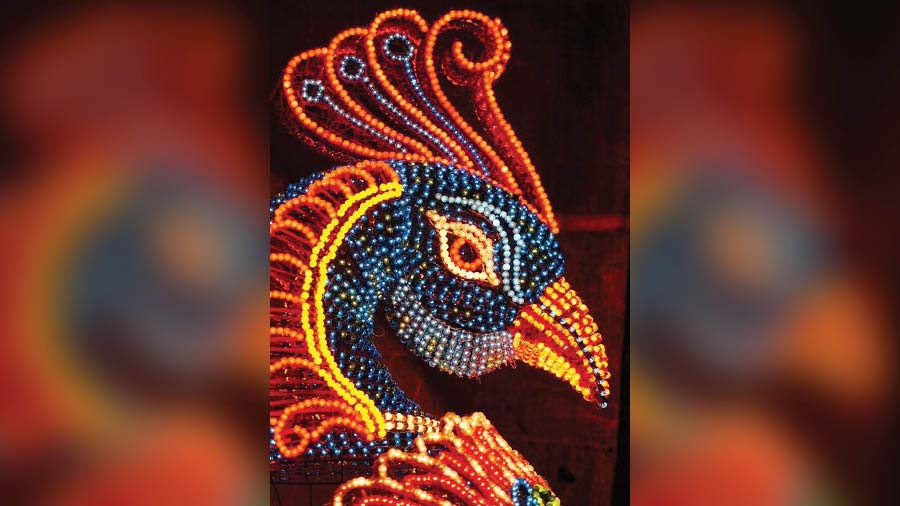
Sridhar Das’s 3D ‘Mayurpankhi’ at the Thames Festival in London_ Photograph courtesy: Martin Good
Sridhar built a fairytale world of illumination that made a toddler and a gaffer stare with awe at the same time. A flight of imagination setting him apart, Sridhar is blessed with a blend of imagination and humanism. “I used to observe a lot. The Pujo theme for light panels is a popular one. While other artists made Pujo-themed light panels with the images of the usual dhaak, idols, rituals, people pandal-hopping and the pomp, my panel ended with a little boy picking up waste paper strewn on the road, the day when the city goes silent after Pujo,” he said as he walked out of his office with a smile of satisfaction.
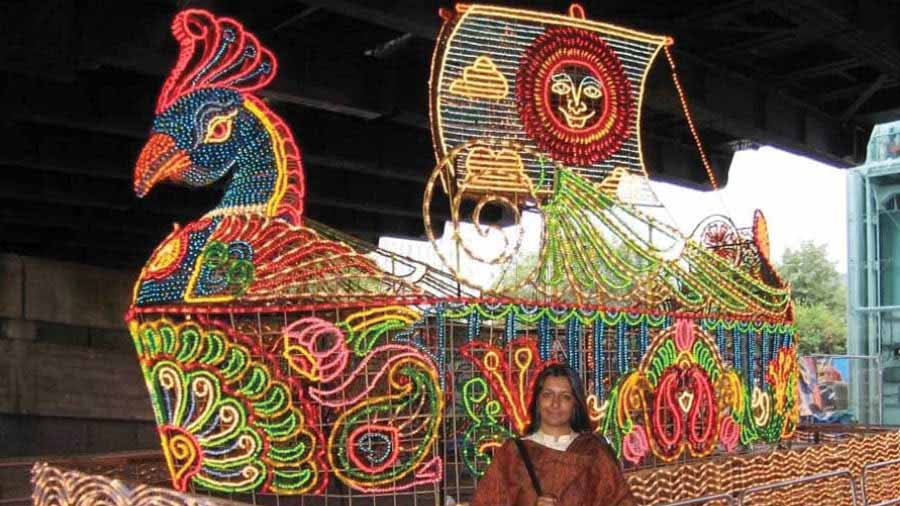
Mayurpankhi Bojra at The Thames Festival Photograph courtesy: Nandita Palchoudhuri
